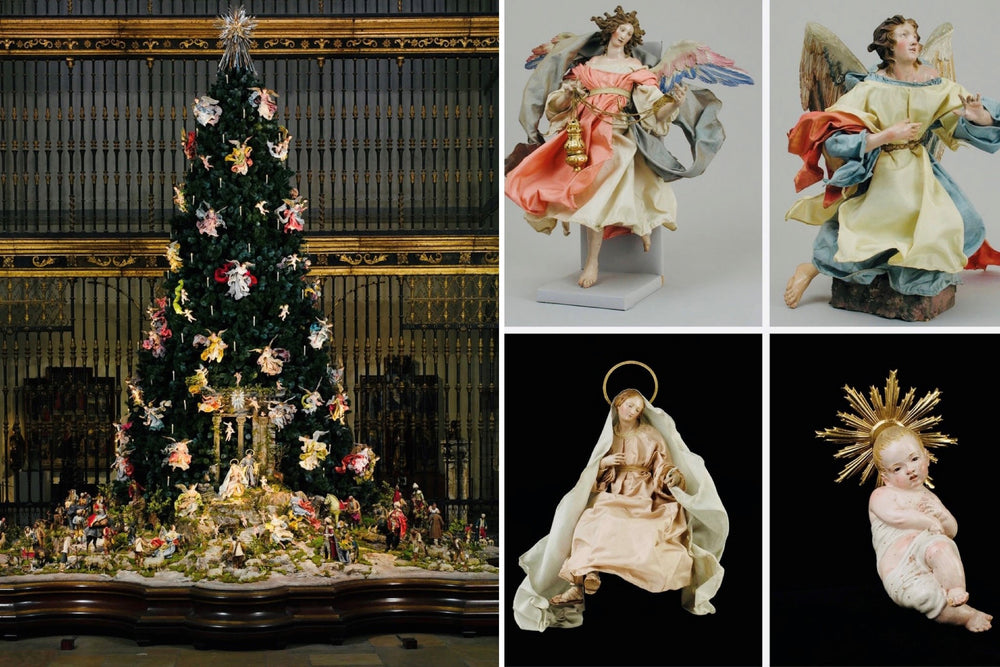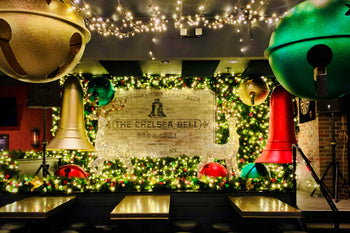Everyone has different ways of marking the beginning of the holiday season. For some, it may be a wreath on the door; for others, Christmas ornaments popping up for sale in the stores, or starting to think about what to get Great Aunt Clara for Christmas this year. For many people though, it’s when a particular symbol of Christmas reappears, such as the sight of a favorite Christmas tree in a particular venue.
In NYC, the lighting of the massive Rockefeller Center Christmas Tree is a sign to many that the holiday season is upon us. However, for a number of devotees and art-lovers, that symbolic tree is actually the Christmas tree and Neapolitan creche in the Metropolitan Museum of Art.
The Christmas Tree at The Met
The 20-foot blue spruce is generally unveiled to the public the Monday of Thanksgiving week (although work on it starts much earlier in November; the tree itself is put together in sections) and is on display until the end of the first week in January. Though artificial, it looks incredibly lifelike. The tree is positioned in the Medieval Sculpture Hall, in front of the beautiful, more-than-50-foot-high Spanish choir screen from the Cathedral of Valladolid.
The tree itself is decorated with an array of 60 angels and 20 cherubs dating from the 18th century. The figures are large—ranging between twelve and fifteen inches--and are made of materials including carved wood (the arms and legs), wire (the bodies, along with tow, a kind of fiber), and terracotta (the heads and shoulders). Their robes are made of silk, and the figure are moldable--they can be posed in different positions.
Neapolitan Baroque Crèche
The Neapolitan crèche circling the base of the tree includes more than 100 figures. They include the Nativity, with shepherds, angels, and sheep; the crowd of people from both the town and the country, and the three Magi on their way to see the baby Jesus with their attendants. The multicultural scene reflects the population of the coastal town of Naples. The scene also includes 50 animals, plus homes and even a fountain. Many of the figures are credited to Giuseppe Sammartino, a famous Italian sculptor. The height of the figures depends on where they were meant to be displayed.
The figures were presented to the museum in 1964 by Loretta Hines Howard, who had started collecting them in 1925 as a child. Softly piped-in Christmas music and tiny lights add to the ambience.
Be sure to walk all the way around the tree so you can see it from different vantage points. Many of the figures wear gorgeously decorated robes, replete with embroidery and tiny jewels. For example, one of the king’s attendants wears a green satin robe with silver and gold metallic thread; a leather-lined velvet belt; a brass sword; a wooden and ivory staff; and jewel-like glass stones on his turban.
The attention to detail is remarkable: A shepherd dangles a fish at the end of his fishing line; an ivory horse sports a satin saddle blanket with metallic thread; a gold braided mane; and silver stirrups and silver braided reins.
Family Suggestion: If this is a family outing, have kids find various figures or objects that you describe to them.
Positioned as it is in the middle of the museum on the first floor, you’ll probably come upon it as you wander around the galleries. However, it’s definitely worth seeking out. It may not be the best-known Christmas tree in New York, but it’s certainly one of the loveliest!
The Metropolitan Museum of Art is located at 1000 Fifth Avenue at 82nd Street. and is pay-what-you-wish for all New York residents. Tickets can also be found at The Met Official Website.




